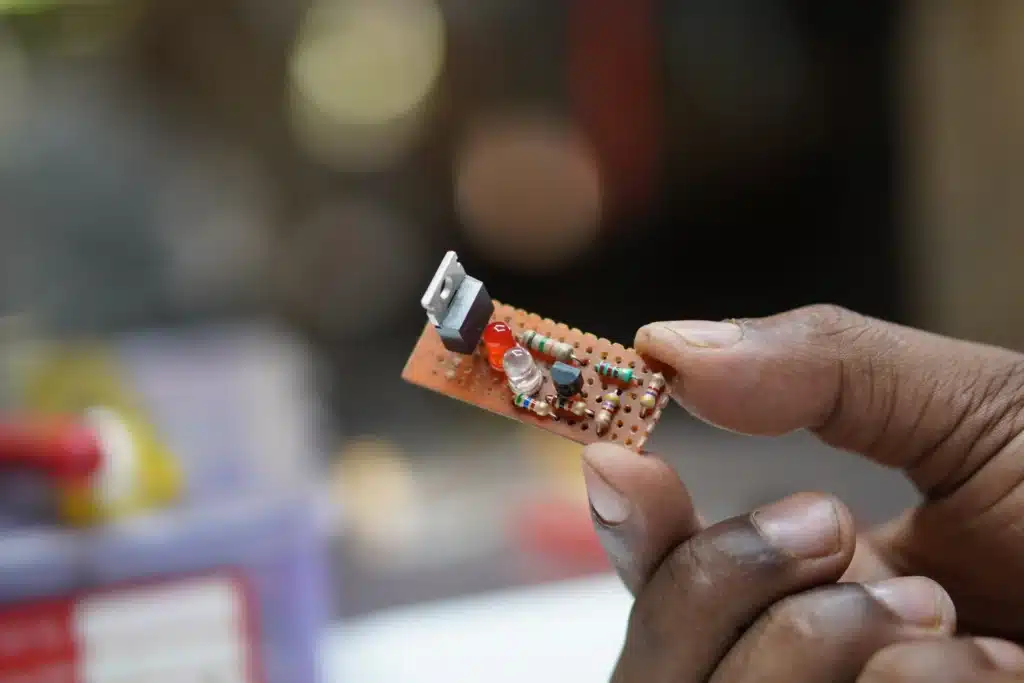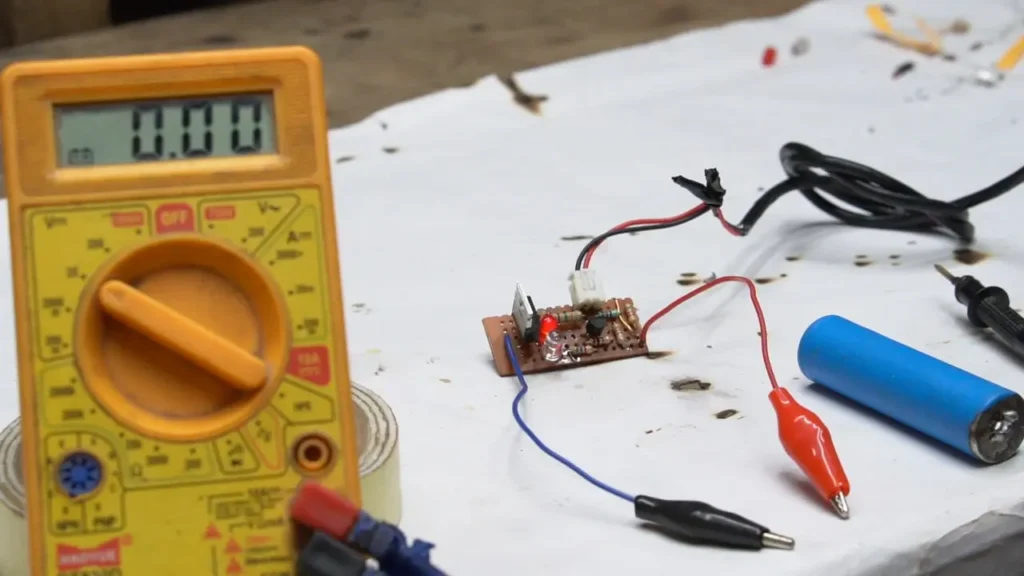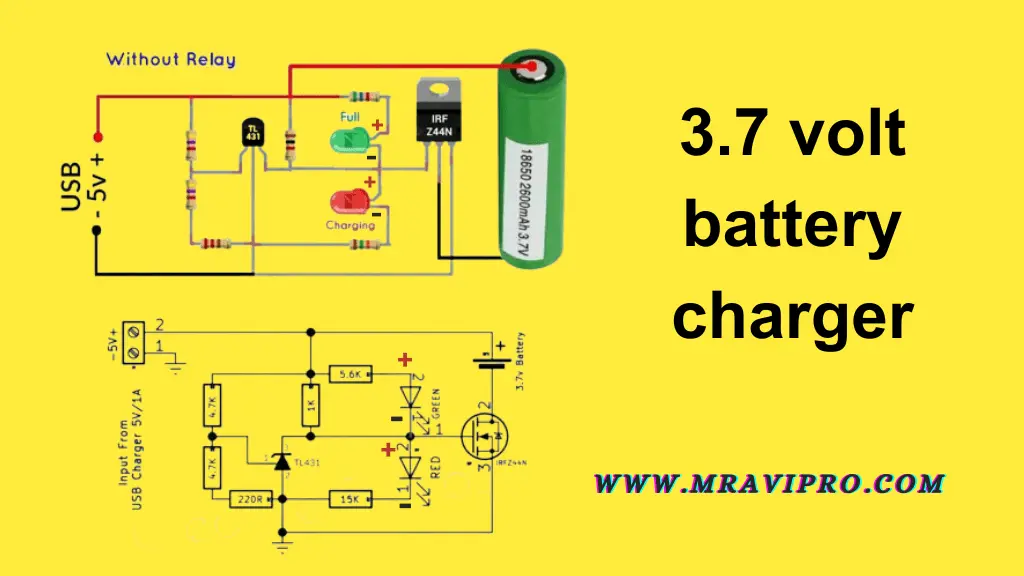Charge 3.7V Li-ion batteries using 5VDC. One example is based on the microchip MCP73831, which is a linear charge management controller that employs a constant current/constant voltage charge algorithm1. Another example is based on a PNP transistor and a TL431 shunt regulator, which can be adjusted to stop the charging process when the battery reaches 4.2V2. You can also use an LM317 voltage regulator to charge the battery up to 4.1V3.
You can download the circuit diagrams from the web search results by clicking on the index numbers.

What is a 3.7Volte Li-ion Battery Charger?
3.7V lithium-ion battery used in smartphones, laptops, and cameras. 3.7V Li-ion battery charger can provide a constant current and voltage to the battery until it is fully, charged¹³. There are different models and brands of 3.7V Li-ion battery chargers available in the market, such as Verilux®¹ and HAST HIP®², which have different features and specifications. The operation of a 3.7Volte Li-ion Battery Charger involves several stages to ensure efficient and safe charging. Here’s a breakdown of the typical charging process:
Initialization and Pre-Charge
During this stage, the charger performs an initial check of the battery’s voltage and condition. It then applies a low current to pre-charge the battery gently. This step helps ensure the battery is ready for the main charging process.
Constant Current Charging
In this stage, the charger delivers a constant current to the battery, gradually increasing the voltage. The constant current ensures a controlled and efficient charging process, allowing the battery to absorb the energy effectively.
Constant Voltage Charging
Once the battery reaches a predetermined voltage, the charger switches to the constant voltage charging mode. Here, the charger keeps the voltage steady while the current gradually decreases. This stage allows the battery to reach its maximum capacity without overcharging.
Trickle Charge (Optional)
Some 3.7Volte Li-ion Battery Chargers offer a trickle charge stage, which provides a minimum current to maintain the battery’s charge at its peak level. This feature is particularly useful for batteries that are not immediately put into use after charging.
Key Features of a 3.7Volte Li-ion Battery Charger
When choosing a 3.7Volte Li-ion Battery Charger, it’s essential to consider its features and capabilities.
- LCD Display: An LCD screen provides valuable information about the charging status, battery voltage, and current. This feature enhances user experience and allows for easy monitoring of the charging process.
- Compatibility: Ensure that the charger is compatible with the specific Li-ion battery you intend to charge. Different batteries may have different voltage and current requirements.
- Portability: If you need to charge your batteries on the go, consider a compact and lightweight charger that is easy to carry in your bag or pocket.
- Fast Charging: Look for chargers that offer fast charging capabilities, enabling you to quickly power up your batteries when time is of the essence.

Benefits of Using a 3.7Volte Li-ion Battery Charger
. Using a 3.7Volte Li-ion Battery Charger provides several advantages over traditional charging methods. Let’s explore some of the benefits:
- Optimized Charging: These chargers are specifically designed to provide the optimum charging conditions for Li-ion batteries, ensuring longer battery life and improved overall performance.
- Efficiency: With advanced charging algorithms and circuitry, a 3.7Volte Li-ion Battery Charger can charge your batteries more efficiently, reducing charging times and minimizing energy wastage.
- Versatility: The ability to charge various 3.7V Li-ion batteries makes these chargers versatile, accommodating the charging needs of different devices and battery sizes.
- Safety: Built-in safety mechanisms protect your batteries from overcharging, overheating, and short circuits, preventing potential damage and extending their lifespan.
- Convenience: The compact and portable nature of these chargers allows you to charge your batteries anywhere, anytime, without being restricted to a wall socket.
- Long-Term Cost Savings: By extending the life of your Li-ion batteries through proper and optimized charging, a 3.7Volte Li-ion Battery Charger.
Circuit Diagram Details

electronics all components list
- Irfz44n n-channel MOS FET (USE ANY TYPE MOS FET ONLY N-CHANNEL)
- TL 431 transistor
- 1k resistor
- 4.7k resistor (2)
- 5.6k resistor
- 15k resistor
- 220 Ohm resistor
Also, Read This Article:- How to Make a BLDC Motor ESC Using MOSFET Also, Read This Article:- How to Make Wireless LED Light Also, Read This Article:- How to Make a Brushless BLDC Motor ESC Controller
Conclusion
When charging 3.7V Li-ion batteries, the 3.7Volt Li-ion Battery Charger is a reliable and efficient solution. With its optimized charging process, safety features, and versatility, it offers numerous benefits to users. By investing in a high-quality charger and following proper charging practices,
You can ensure longer battery life, improved performance, and enhanced convenience for your portable electronic devices. So why wait? Upgrade your charging experience with the power of the 3.7Volte Li-ion Battery Charger!
3.7Volte Li-ion Battery Charger Video
FAQ
Can I use a 3.7Volte Li-ion Battery Charger for other battery types?
No, a 3.7Volte Li-ion Battery Charger is specifically designed for 3.7V Li-ion batteries. Using it with other battery types can result in improper charging, potential damage, or even safety hazards.
Can I leave my batteries on the charger after they are fully charged?
It is generally recommended to remove your batteries from the charger once they are fully charged. Leaving them on the charger for an extended period can cause overcharging, which can be detrimental to battery life.
Is it safe to charge my batteries overnight?
While some chargers offer safety features that minimize the risk of overcharging, it is generally advisable not to charge batteries unattended or overnight to mitigate any potential safety hazards.
Charge a 3.7v lithium battery how long does it take?
Battery capacity and charger current output can affect charging time. A full charge typically takes between two and six hours. Refer to the manufacturer’s specifications for exact information.